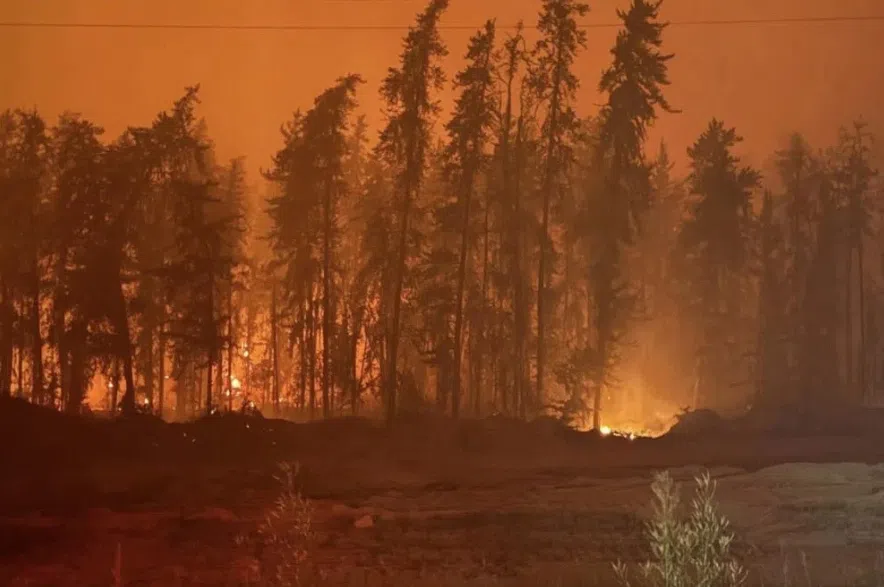It has been a record season for wildfires in Saskatchewan, and while the smoke has a direct impact on people’s health, it is also affecting long term water security in the province.
Dr. John Pomeroy, director of the Centre for Hydrology at University of Saskatchewan (U of S) was a guest on The Evan Bray Show on Monday and described the impact on glaciers in the Rocky Mountains, which feed the South Saskatchewan River from which the province draws most of its water.
Read more:
- Massive Shoe Fire remains uncontained as 84 blazes burn in Saskatchewan
- Full coverage of Saskatchewan Wildfires in 2025
“Those glaciers tend to melt in the hottest, driest weather, so they provide some drought proofing for our rivers,” he said, adding that this has historically helped with water management in Saskatchewan.
He said sunlight is mostly what causes the glaciers to melt.
“When they’re white and clean they reflect most of that sunlight and melt very slowly … however they’ve been darkening up because of soot from wildfires deposited on their surfaces … so they absorb a lot of solar energy and they melt very, very quickly.”
Pomeroy said “even stranger” was the fact that some of the glaciers are seeing algae blooms, which thrive in the nutrients the wildfire soot provides. The blooms hold the soot in place for years at a time, he said.
The glaciers are melting downward eight to nine metres a year, he added, which translate to “much more challenging” situations in drought years in the Alberta, Saskatchewan and Manitoba.
To add to the problem, Pomeroy said declining snowfall is not helping the water situation.
“This year snowfall in the mountains was about two thirds of normal levels, and we sure saw that in Saskatoon with low river levels and low Lake Diefenbaker levels this spring and early summer.”
He said low snow levels also affect the glaciers because it exposes the soot-covered ice earlier, adding that this years the snow melted on the glaciers in April when normally it would not be seen until July.
“We’re seeing the final end of the Ice Age, in this case it’s being driven by humans, by the extra warming that we’ve caused by greenhouse gasses.”
Pomeroy believes it is going to mean substantial adaptation in Western Canada.
“I don’t think we’ll see the rivers go dry but … this year looked worse than the drought in 2023,” he said.
U of S monitors two glaciers in the Rockies with instrument stations.
“It’s very challenging to do, and it means putting weather stations on the ice, and the glaciers are retreating fast,” he said.
Pomeroy said “lucky” rainfall could replace some of the river and lake water but how the province operates Lake Diefenbaker is going to be “crucial” to maintain water supply.
“It’s not guaranteed every year, so what’s been reliable for us in the past has been that mountain snow melt, which is providing over half of the river flow that we see in Saskatoon.”
“Cooling off isn’t going to be occurring in our lifetimes,” Pomeroy said. “We’re on track for another three or four degrees of warming that the youth will see in their lifetimes now.”
Wildfires in Saskatchewan on Aug. 18
There were 67 active fires burning in Saskatchewan on Monday.
Saskatchewan Public Safety Agency (SPSA) said in a 5 p.m. report that seven of those blazes were not contained, while another 35 of the fires were under ongoing assessment and firefighters were protecting values in 16. Nine fires were considered contained.
Contained means suppression action is taking place and the fire is not expected to grow in size, ongoing assessment means the fire is being monitored regularly to assess risk to values in the area and not contained means suppression action is taking place but the fire is expected to grow in size, according to SPSA. Protecting values means a fire is active and action is focused on protecting things like cabins and infrastructure.
SPSA says there have been 467 fires in Saskatchewan so far in 2025. The five-year average to date for Saskatchewan wildfires is 380.
— with files from Will Mandzuk
Read more:












